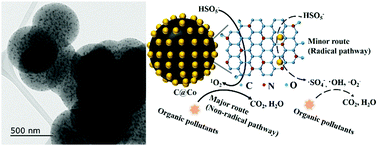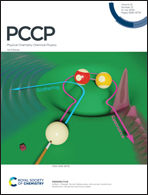Co nanoparticle-embedded N,O-codoped porous carbon nanospheres as an efficient peroxymonosulfate activator: singlet oxygen dominated catalytic degradation of organic pollutants†
Abstract
In this study, Co nanoparticle-embedded N,O-codoped porous carbon nanospheres (C@Co) with abundant N and O doping, high graphitization, large specific surface area (319 m2 g−1) and a well-developed mesoporous structure were synthesized and characterized thoroughly, and were applied to activate peroxymonosulfate (PMS) for the degradation of methylene blue (MB). Various influential factors affecting the catalytic performance including C@Co dosage, PMS dosage, MB concentration, initial pH, temperature, and co-existing common anions and humic acid (HA) on the MB degradation were systematically investigated. The increase of the C@Co dosage (15–60 mg), PMS dosage (25–100 mg) and reaction temperature (278–308 K) promoted the MB degradation in the C@Co/PMS system. The best performance of the C@Co/PMS system was observed under weakly acidic or nearly neutral conditions. Both the MB concentration (25–100 mg L−1) and Cl− (5–100 mM), NO3− (10–500 mM), CO32− (10–300 mM), HCO3− (1–30 mM) and HA (2–40 mg L−1) had an inhibitory effect on MB degradation, and the degree of decrease in MB degradation increased as their concentrations were enhanced. Interestingly, HPO42− (1–100 mM) had an overall inhibitory effect on the degradation process of MB; however, in comparison with lower concentrations (1–10 mM), an attenuation of the inhibitory effect at higher concentrations (50–100 mM) could be observed. Moreover, the C@Co/PMS system also exhibited general applicability in eliminating various organic pollutants from water such as methyl orange, malachite green, safranine T, Congo red, Rhodamine B, ofloxacin and tetracycline. Classical radical-quenching tests and EPR measurements showed that both the non-radical pathway (major route, involving 1O2) and radical pathway (minor route, involving ˙OH, ˙SO4− and ˙O2−) contribute to the MB degradation. DFT calculations disclosed that the combination of Co–C interactions with graphitic N doping brought in catalytically active sites in C@Co where the charge states of some C atoms were significantly increased. The degradation intermediates of MB during the catalytic reaction were also identified by HPLC-MS and the possible degradation pathway was proposed. Overall, the resultant C@Co can be developed as a novel and efficient heterogeneous catalyst for activating PMS to degrade organic pollutants, and has potential application in environmental remediation.



 Please wait while we load your content...
Please wait while we load your content...